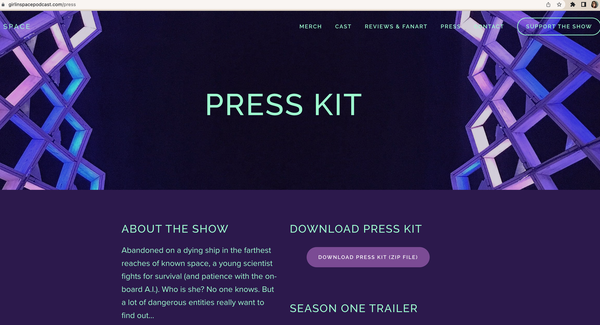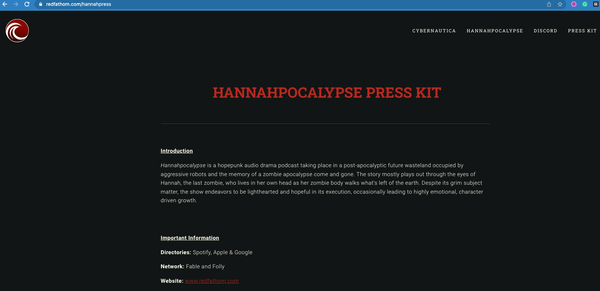Podcast Media Kit Examples, Tips, & Resources: Amplify & Attract
Does your podcast need a media kit? Yes, definitely. A podcast media kit is a package of information about your podcast that’s easy to share and consume.
Think of it as an appetizer sampler platter. It’s a condensed, snack-sized, flavorful version of your work, that makes listeners want more.
You might shake your head, smile, and turn back to another one of these shiny AI tools that can generate your press kit materials for you. That’s fine; we have a guide to AI podcasting tools to help you evaluate which is best for your purposes.
But, knowing how to construct a podcast media kit of your own will help you understand why and how a good media kit works.
True, it’s added work. But whether your podcast is an income stream or a fun hobby, a media kit is worth your time and energy.
A good podcast media kit does all of the following:
- Helps listeners to find and share your podcast
- Builds a relationship with sponsors
- Gives journalists key information for articles about your podcast
- Shows your podcast’s unique value proposition,
- Persuades guests to participate in your show
- Condenses and sums up your podcast for future pitches
Bookmark this guide. We’ll discuss media kit terminology, what goes into a media kit (along with how to construct those elements), and how to use a media kit to engage audiences, sponsors, and guests.
What’s the Difference Between a Media Kit, a Press Kit, and a Press Release?
Let’s get some terminology out of the way up front.
Media kits are sort of like press kits, for those of us old enough to remember printing presses (hello!). But unlike press kits, which were mainly just text and statistics, media kits are more technologically sophisticated and dynamic.
Free templates in Canva or other design software make a visually stunning podcast media kit that goes far beyond what’s possible in a Word document. But we’ll get to the how-to shortly.
So, What’s a Podcast Press Release?
A press release is part of your podcast media kit. It typically announces the launch of a new podcast, a milestone reached, or a major change.
Press releases can be effective and may be the first place people learn about your show. But, by definition, they’re temporary, whereas a media kit endures.
How to Plan Your Podcast Media Kit Like a Story
So, how do you create one of these bad boys? First, draft out your thoughts. Ask yourself questions like a journalist: take a moment to write down the What, Who, Where, Why, When, and How of your podcast.
Jot down some short answers in your podcast planner or notebook.
What is your podcast?
This is your podcast description. One meaningful descriptive sentence is perfect.
WHO is your podcast?
Yes, this can be a short bio about you or your business, but it’s also a short bio about your ideal listener. It sounds strange, but you need to tell them who THEY are. For example, “Podcraft listeners are early-stage and aspiring podcasters looking to launch a show optimised to grow and monetize”.
People will either say, “This sounds exactly like me” or “That isn’t me at all”, and both responses are positive. Your podcast can’t be for everyone.
Where is this podcast from?
Did the show grow out of a team-building workshop? Is it uniquely Minnesotan? Does it occur in an unusual environment (such as Hostile Worlds’ starship Tardigrade)? Is it recorded in an unusual place, like your home, a particular recording studio, or a van?
Your WHY?
What do you want your podcast to accomplish? For example, “Hostile Worlds is designed to teach the audience about the universe in an entertaining and accessible way.”
When?
What’s important about your podcast’s past? When did you start, and how has your podcast grown? If you haven’t launched yet, what important dates are coming soon for your podcast? What’s your launch date? What’s your episode frequency?
How?
How can people listen, get in touch with you, and engage with the show? Write down your podcast website URL, social media handles, email address, and RSS feed. Link to your website’s “Listen Now” page: here’s an example of the “Listen Now” page for Podcraft.
Our free Podcast Planner tool will help you a lot, here. It just takes a few minutes to fill out and it’ll give you a lot of suggestions, ideas, and inspiration towards creating your podcast media kit.
How to Make Your Podcast Media Kit
Great! Now that you have drafted all these thoughts into condensed statements, let’s make the building blocks of the press kit itself.
If you want your podcast to be accessible to anyone, the media kit should be the simplest possible multi-tool.
You should create:
- A fact sheet, as a PDF, with a web page version.
- A Google Drive or Dropbox folder
- Copies of your podcast’s art and relevant images, optimized for web and print
The Podcast Fact Sheet
This is where the magic happens. No matter what kind of podcast you have, here are the building blocks of your fact sheet:
- About (your podcast’s description)
- Who’s involved
- Target audience: who is this show for
- Contact information (you’d be surprised how many people forget this)
- How to listen
You can also add some of these, if you have them:
- Awards and accomplishments
- Measures of engagement, like how many followers you have on which social media platforms, how many downloads, or what countries your podcast has been played in
- Reviews or positive social media messages about your content
- A special episode that’s a good one to listen to first
Type the answers to the bullet points above in a Word doc. You’ll copy and paste each block of text into your design software. Design software often can’t check for spelling or typos.
Copy and paste the text you typed in your Word doc into the relevant spaces of your fact sheet template.
Adjust the colors to fit your brand and add the images you want to include.
When the sections are consistent, and everything looks neat and legible, save the document as a PDF and put it in your podcast media kit folder.
Essentially, you summarize your show and what it goes well with, then, gather the images. Once you put it all together, all you’ve spent is time and patience.
What if your podcast doesn’t have great reviews, huge download numbers, or armies of social media followers? Take the good things you have and put them in the spotlight. The rest will follow as you build your audience.
Your Podcast Media Kit Folder
Make it easy for writers to promote you. Some journalists prefer to work offline and would rather have the data about your show in a format they can save to their desktop or print out and read.
Create a folder with a public link, such as a Google Drive or Dropbox zip folder. Set the permissions to view-only. Test the link with a friend to make sure it’s accessible.
Bookmark this link or copy and paste it into a note on your desktop. You’ll be using it often.
You’ll also want to create a web page version of your media kit, which you can update quickly and send to interested parties.
This version of your media kit helps your SEO because search engines will index the information on the page.
Your Podcast Art
A journalist might publish an article about your podcast in print media. If they do, they’ll want an image to make their article stand out.
Images 300 dpi (dots per inch) or more work well for print media. Most art that works on a screen is 72 dpi and won’t be clear in print, so add a 72 dpi and 300 dpi copy of your podcast cover art or logo.
Save your podcast art as a .png or .jpeg to your folder, with a clear name(i.e., “podcast-title-media-kit-print-july2024′), so the recipient can find it easily. Put these in your podcast media kit folder.
Visual Media for Audio Podcasters
Podcasters need to be conscious of the visual elements of their brand. Just like when you’re adding sound effects or music to your podcast, you want to be able to find and use your visual elements quickly.
Make a folder to use as you build your media kit. Put in the images you want to use. Type up a note with the following:
- Your brand colors and their hex codes
- Your brand fonts
Put this folder on your desktop, along with your logo and podcast art files. Name it “[your podcast title] visual assets.” You can pull from this folder as you work on your fact sheet.
Here’s a deeper dive into creating artwork and logos for your podcast, too!
Should My Podcast Media Kit Have Links?
Yes. Link to your podcast website’s “listen now” page, as well as to your podcast’s social media profiles.
It doesn’t matter if the recipient’s going to print the podcast media kit or not. They can still click on the links to get more information.
Additional Content
Over time, there will be different assets to add to the folder. Transcripts, press releases, photos, and updates can go into your podcasting press kit too.
Hubspot has some really cool free business templates to help you populate your folder with things like advertising proposals, event proposal outlines, and mind maps.
Make sure these items all have clear dates and file names.
Podcast Media Kit Templates: Know Your Audience & Niche
When I first started looking at media kits in Canva, the variety and panache of the layouts were staggering. But don’t just pick whatever template seems the boldest or attention-grabbing – be sure your template suits the answers to the questions you initially asked.

You want a template that looks exactly like the mood you want your podcast to convey. So, consider your podcast niche and audience when you pick one out.
You also want to think about content. If your media kit focuses on reviews and descriptions, you may want a template with more text boxes.
A template with more image spaces would fit a podcast that needs images (such as a fashion podcast).
What To Do With Your Podcast Media Kit
Upload your podcast media kit folder to Google Drive or Dropbox. Make sure it’s publicly accessible but view-only. On your website, link to this folder. You can also link to it from your show notes.
Typically, podcast websites have an “About” page, since most users don’t think a media kit applies to them. But, the “About” page can repeat all the information from your fact sheet.
When you invite guests to your podcast, share the media kit with them. A fact sheet for your guests goes a long way to getting that one fantastic star on your show.
Your podcast media kit shows them what to expect, how to prepare, and what your show can do for them.
Keep it short (why not pull some information from our guide on being a great podcast interview guest?) and positive, and they’ll be more likely to show up on time, prepared and confident.
Podcast Media Kit Examples

Girl in Space’s press kit page echoes their podcast media kit fact sheet. It has a link to a Dropbox folder near the top of the page.

Red Fathom has press kits for their shows Hannahpocalypse and Cybernautica. Each is crystal clear and accessible, to the point that these could be useful templates for your podcast media kit.
Elsewhere, Multitude Productions‘ podcasts set a great example with their podcasts’ media kits. They hit all the important talking points for journalists and bloggers.
Instead of labelling these as “press kits.” Multitude puts this info in the “About” section of each site. Click on the “About” tab for their Spirits podcast, and you’ll find one of the most comprehensive and detailed podcast media kits out there.
Your Podcast Media Kit Makes Sharing Your Show Easier
Whilst you spend time building your audience actively, a great podcast media kit helps you build your audience passively.
A media kit makes it easy for your fans, search engines, and writers to share your show.
Legacy media’s traditional press kit structure made it easy for anyone to write about and share the latest TV show, theatre project, or ice cream brand. When you plan the fact sheet’s content, package the information and images accessibly, and put it out there to share, it’s like packing a snack for your future audiences.
When they understand your show, they’ll come back for a full meal – and bring their friends.
A podcast media kit is just one great way to help your show grow. In The Podcraft Academy, you’ll find many more, from our Growth Mastery course to feedback and accountability tools. We’d love to work with you in there!

